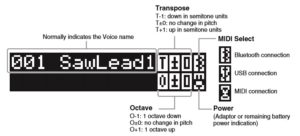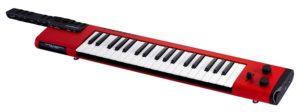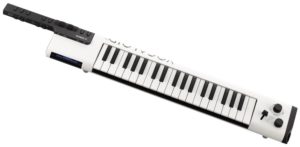With Yamaha PSS-E30 Remie at hand, I’m still comparison shopping the PSS series against the Yamaha SHS-500 Sonogenic. The Sonogenic has better build quality, has 5-pin MIDI as well as MIDI over USB/Bluetooth, and integrates with Chord Tracker.
Then there is the issue of sound quality. Remie and the rest of the PSS series (PSS-F30 and PSS-A50) have only one main DSP effect: reverb. With the exception of the A50’s motion effects, there aren’t the means to tweak sounds.
As to preset voices, I would love to play Remie and Sonogenic side by side. However, in this day and age when brick and mortar stores do not stock inventory or demo units, that’s impossible. Gosh, I ordered Remie from the UK — I live in the big Seattle USA metro area — with the intention of gifting it to our grandson. (A good excuse. 🙂 ) The PSS series keyboards are so inexpensive that even an impulsive purchase is justifiable. I still haven’t seen a Sonogenic alive in the wild and don’t have hand-on experience with it (yet).
First some tech-head stuff. Remie has 32 voice polyphony and my teardown shows that it is based on the tiny Yamaha SWLL (YMW-830) system-on-a-chip (SOC). It stores its program and waveforms on a 2MByte ROM. Right away, I expect Remie’s sound quality to be compromised with respect to the current PSR E-series.
The current PSR E-series is based on the proprietary Yamaha SWX03 processor. The SWX03 is a much larger SOC with external RAM, ROM, digital to analog conversion (DAC), analog to digital conversion (ADC), and LCD display interface. The program/wave memory is 32MBytes (Spansion S29GL256) much larger than Remie. The SWX03 supports 48 voice polyphony and 10 DSP effects in addition to the usual PSR E-series reverb and chorus. Thus, I expect better sound quality from the E-series.
The SHS-500 also has 48 voice polyphony and 10 DSP effects. These characteristics alone make a strong case for the SWX03 as the main engine within the Sonogenic.
Hearing is believing, however. Without access to Sonogenic in the stores, I’m forced to compare Remie and PSR against YouTube videos. One of the best Sonogenic voice demonstrations is in Japanese by a laid-back jazzer. I also recommend this Sonogenic demonstration in Russian.
The Japanese demo gets rolling roughly 3:30 in. Our jazzer compatriot plays through the presets without a backing track or lots of effects. This is as close to factory stock as one can get. Thank you! Here are direct links to some of the Sonogenic instruments in the video:
- Underheim 4:45
- Analogon 5:05
- E.Piano 5:35
- DXPiano 6:40
- E.Guitar 7:20
- J.Guitar 7:40
- SynBass 9:30
- Piano 10:40
- Pno&Strs 11:08
- Pno&Pad 11:22
- AirChoir 11:35
- Strings 11:50
- Brass 12:05
- Trumpet 12:24
- Flute 12:46
- AltoSax 13:05
- TenorSax 13:40
These sound pretty good and much better than Remie. The electric piano can bark! The jazz guitar is decent. Many of the brass and woodwind instruments have vibrato sampled in.
The Sonogenic program change table gives us a major clue about the origin of the Sonogenic voices. Most of the Sonogenic voices match up with the PSR series:
SHS-500 Bank Bank
Sonogenic MSB LSB PC# PSR/Genos voice
----------------- ---- ---- --- -----------------------
Saw Lead 1 104 20 91 Gemini
Saw Lead 2 0 104 82 RS Saw Lead1
Quack Lead 0 112 85 Portatone
Bright Decay 104 21 85
Square Lead 0 112 81 Square Lead
Under Heim 104 51 88 Under Heim
Analogon 104 52 82 Analogon
Synth Brass 0 113 64 Ober Brass
Electric Piano 104 28 5
DX Electric Piano 0 112 6 DX Modern
Electric Guitar 104 3 31
Jazz Guitar 104 0 27 Cool! Slide Jazz Guitar
Acoustic Guitar 0 117 26 Steel Guitar
Electric Bass 104 6 34
Slap Bass 0 112 37 Slap Bass
Synth Bass 0 112 39 Resonance Bass
DX Bass 0 118 40 DX100 Bass
Piano 0 112 2 Bright Piano
Piano & Strings 104 39 1
Piano & Pad 104 40 1
Air Choir 0 112 55 Air Choir
Strings 0 116 49 Bow Strings
Brass 0 117 63 Pop Brass
Trumpet 0 115 57 Sweet! Trumpet
Flute 0 115 74 Sweet! Classical Flute
Alto Sax 104 2 66
Tenor Sax 104 3 67
Harmonica 0 112 23 Sweet! Harmonica
I verified the matches by comparing the YouTube video against the same voices on Genos. (Removing the Genos effects, of course.) The blank spots in the table are voices which Yamaha re-sampled from PSR or elsewhere. That’s why the electric piano is so darned good. The piano layer voices have a warmer, mellower timbre than the Bright Piano (which really lives up to its name).
So, there you have it. On the basis of sound quality, the Sonogenic SHS-500 wins over the PSS family. Yes, the Sonogenic is more expensive, but you do indeed get more for the money. If Sonogenic had even a single organ voice, it would be a no-brainer and I would have bought one by now. Oh, Yamaha, why do you leave these things out?
Copyright © 2019 Paul J. Drongowski



